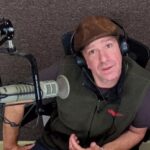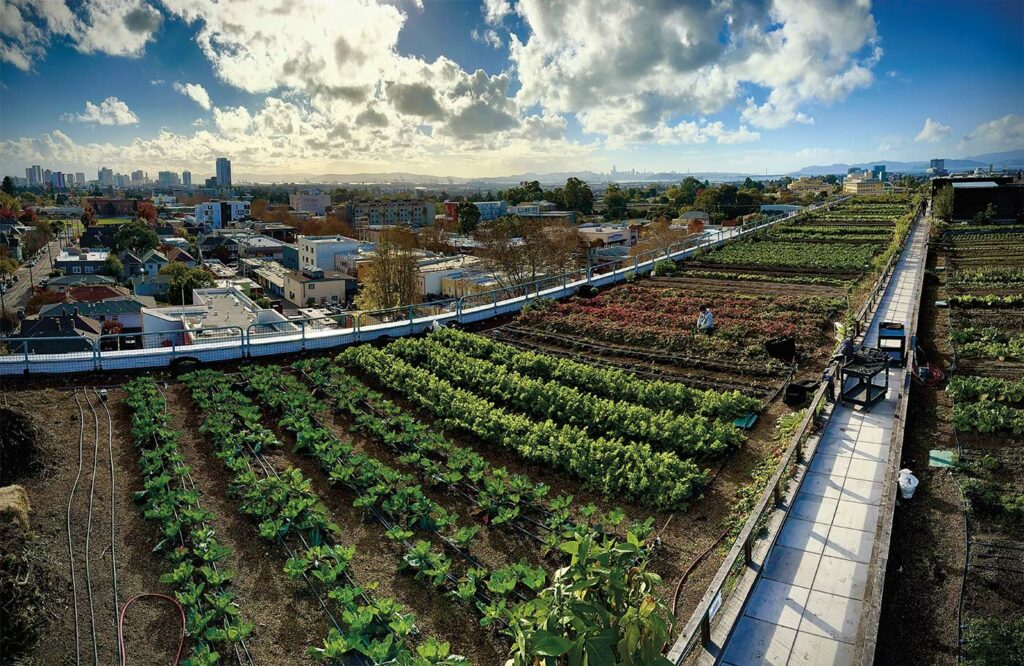
Visionaries Rupa Marya and Ben Fahrer farm major solutions, from the ground up
PHOTOGRAPHY BY MARK C. ANDERSON
Dr. Rupa Marya is shouting from the rooftop.
And it’s not just any rooftop. Deep Medicine Circle’s farm in Oakland is the largest rooftop planting on the West Coast and the most productive urban food plot in the San Francisco Bay Area.
On its design merits and organic output alone, it’s a wonder to take in, skyline views aside. As it provides nutrient-rich produce to food insecure souls at a dozen-plus places like UCSF Claremont Clinic and Poor Magazine, the farm also provides wildlife habitat, stormwater mitigation and replicable practices for city-centered agroecology everywhere.
And these aren’t just any shouts, but blueprints sown from a broad coalition, exhaustive research and Indigenous wisdom: Heal soils to heal people. Restore connection to land and one another. Make healthy produce a human right.
“I am inspired by dismantling colonial capitalism,” Marya says. “That mindset has decimated wildlife; it has destroyed our waters; it has made the air unbreathable; and it has written the scourge of chronic inflammatory disease on all of our bodies.
“Beautiful things emerge in the compost of that failed system.”
She’s surrounded by a rapt audience of thinkers attending the 2023 Bioneers Conference tour. As an author and activist, organizer and abolitionist, practicing physician and professor of medicine at UCSF, she’s more than qualified for the platform.
But she doesn’t reference that background in this talk. She also declines any mention she’s a world-touring singersongwriter- guitarist-front woman for Rupa & the April Fishes. (That’s the same group that accepted heirloom seeds as admission to shows and distributed seed packets with each song release of its latest album, Growing Upward.) Marya emphasizes a different qualification instead: She married a farmer.
“I [was looking] for a computer hacktivist or a seed saver,” she says. She found the latter in Big Sur.
Call it an organic meet-cute: Marya was on tour with the April Fishes in 2011, visiting Esalen Institute for a festival. There she met Ben Fahrer, a Carmel native and permaculture expert, who was managing Esalen’s crops and leading related workshops. When they reconvened months later, he reconsidered his plan to travel the world teaching agroecology. “It was that life or love,” he says. “Love prevailed.”
For true dirt and nutrition nerds out there, the couple’s sexiest moment came later, when they started comparing field notes.
Before that happened, Fahrer and his Top Leaf Farms team had already spearheaded the buildout of the rooftop farm, which blooms with everything from bell peppers and bok choy to sweet peas and Swiss chard. Meanwhile the couple assembled DMC’s vast collective of elders, healers, herbalists, educators and physicians, who pollinate food-as-medicine mindfulness in every direction, reminding everyone listening, as Marya says, “We’re a living system within a living system.”
Now—as she ached to understand the underlying causes of the chronic conditions disproportionately represented in the people of color she treated—the couple observed something in her patients’ physicals and his analyses of various farms.
She described what they found to virtual EcoFarm attendees in 2021: Soil and stool health followed similar tracks. And no one was paying attention to the connection between nutrients in the ground and healthy functions in the gut. The primary fix, she announced in her keynote: “We should treat farmers the way we treat our doctors.”
“Healthy soil equals healthy food, which equals healthy people,” Fahrer says. “Our food is only as healthy as the soil is.”
The revelations led to a book Marya co-wrote with political ecologist and food systems activist Raj Patel. Inflamed: Deep Medicine and the Anatomy of Injustice (2021) looks at how the human body, society and the planet are aggravated in parallel patterns that happen to be intimately linked.
Solutions wait patiently in Indigenous histories. As the introduction to Inflamed points out: “These connections are not new. Nor are they ours.”
In the process, Marya, Fahrer and company solidified the foundation from which Deep Medicine rises: re-establish Indigenous-minded stewardship of land; treat farmers as the frontline health workers they are; make nutrition universal; remember food works best as medicine, not for profit.
“We have an opportunity to reawaken our relationships with our soils and foods,” Marya says. “But that’s not achieved through sitting around and meditating.”
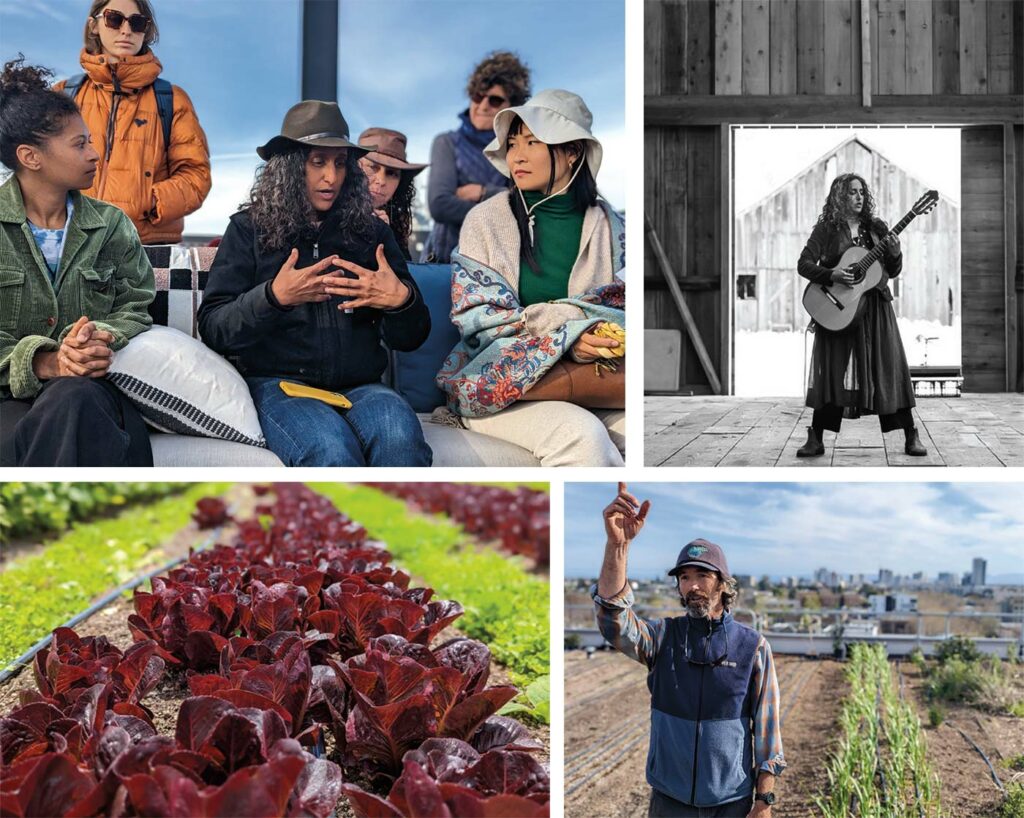
DOWN TO EARTH
On the coast just north of Santa Cruz County, in fertile fields of unincorporated San Gregorio (population 214), next to a small river corridor vibrant with native species, sits a 38-acre farm named Te Kwe A’naa Warep, “Honoring Mother Earth” in native Ramaytush.
In 2020, Marya and Fahrer submitted a proposal to steward the land to the Peninsula Open Space Trust. The pitch came after local Indigenous groups invited them to consider the opportunity. That collaboration with the native community—and DMC’s forethought, track record and relationships in farming circles—helped it beat out 30-plus other contenders.
Today the rooftop’s sea-level sister grows many of the same things they do in Oakland—carrots, lettuces, melons, onions, radishes, ginger and indigo among dozens of other items—while cultivating more than crops.
Hints to that end appear inside the big barn at its center, next to the greenhouse loaded with organic starts and the farmhouse where the harvest manager lives.
Within the barn’s soaring walls, braided garlic dangles from cross struts. An assemblage of drums awaits a session. Sun streams through the broad door where Marya recently power-posed with her guitar and a social media caption that reads, in part, “When you cease making distinctions that separate art from healing from earth from fire from being from decaying…everything is music.”
Past the fluffy farm dog watching from the barn floor, toward the ocean, rows of rainbow chard and fruit trees curve with topography tended by hand tools.
Flower bundles surround the work at hand for DMC administrative aide Gabriella Lola: lettering signage for a community U-pick later that week.
Twenty-one-year-old Lola’s Northern Pomo and Kletsel Dehe Wintun heritage helped guide her here from her native Mendocino County.
“For many, there is difficulty understanding food policy and landback work because we’ve gotten adapted to capitalistic structures to feed our families,” she says. “It goes back to reminding people that healthy food is a human right.”
The farm occupies an auspicious place on the coast. Very near here in 1769, Gaspar de Portolá encountered natives who helped nurse his sickly crew to health, only to massacre them later.
Keeping that history front of mind and center of heart grounds the project. Charlene Eigen-Vasquez is a descendant of Ohlone inhabitants from the village of Chitactac near Gilroy and DMC’s landback program director. She helps coordinate tribal collaboration, brokering peacemaking rituals and bringing Indigenous groups to the land that, over time, will shift to their care.
“As we heal the land, we heal the people,” she says. “By working on the land, nurturing it and reintroducing species, we can renew plant relations and animal relations that were once there. What’s following that is the people, then the songs and the ceremonies.”


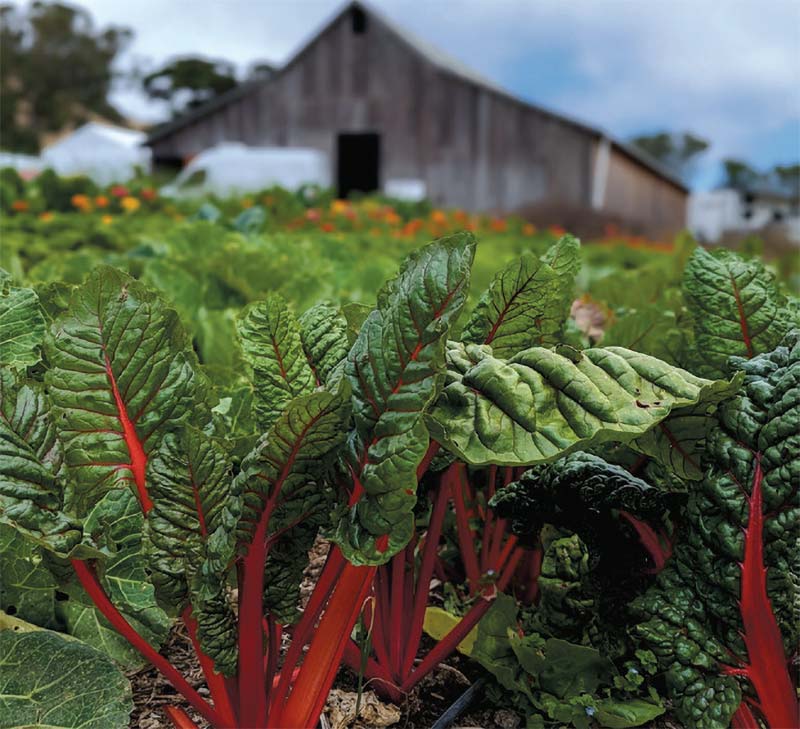
PIECING IT TOGETHER
Picture an impossible jigsaw puzzle.
That’s how some describe Deep Medicine Circle’s endeavor to offer free greens to those who need it most, to reimagine health care’s fundamentals, to take on centuries of colonization.
Fahrer embraces the comparison. How to take on something so complex? Like you would a jigsaw puzzle.
“Take care of edges first,” he says. “We’re trying to create the framework in one district in Oakland: to [build] a food utility, to make healthy vegetables a right and document it so other communities can try to replicate it.”
The effort has DMC tracking data on inputs, harvests, staffing, outreach, storytelling and other lessons learned the uneasy way, across months of measurement, to produce a toolkit for other farms and communities.
That process is completing year two as this publishes; the plan after year three is to share everything online with open-source accessibility.
“It’s a rich case study,” Marya says. “Some pieces might be applicable in some places, and some won’t. We’ll say, ‘This works,’ ‘This is what we would’ve done differently,’ ‘Here are the challenges,’ ‘What happened, and what did we learn?’”
Deep Medicine Circle also hopes to use the toolkit to win backing for food-as-medicine projects from interested public institutions like the University of California system and local municipalities.
“It will be there for anyone who wants to replicate it,” Fahrer says.
In other words, this is not a socialist fever dream. It’s a merit model where the depth lies in the thought going in, the knowledge coming out, and the partners on board, which include the city of Oakland, Berkeley Food Institute and The Rockefeller Foundation.
Other puzzle pieces find their place through Te Kwe A’naa Warep’s relanding: Eigen-Vasquez reports tribes from New York to Wisconsin to Montana to Washington state are watching—and contributing.
“Because [tribes] know it’s happening, they’re offering seeds,” she says. “Tobacco, sweet grass, different corn, beans. They’re following our work.”
Everything, it turns out, is connected, positive changes included.
Marya saw as much in a patient’s mood swing she described for the Bioneers on the rooftop last spring. A Bay Area local she’d known for 20 years, only to lose track of during COVID, came in eager to hear how the April Fishes were jamming along.
“I can’t play music right now!” she said. “I have to grow food.”
His face fell—until he learned it was his doctor who hauled in the hyper-fresh produce for him to take home.
“Wait—you brought the lettuce?!” he asked.
He felt better already.
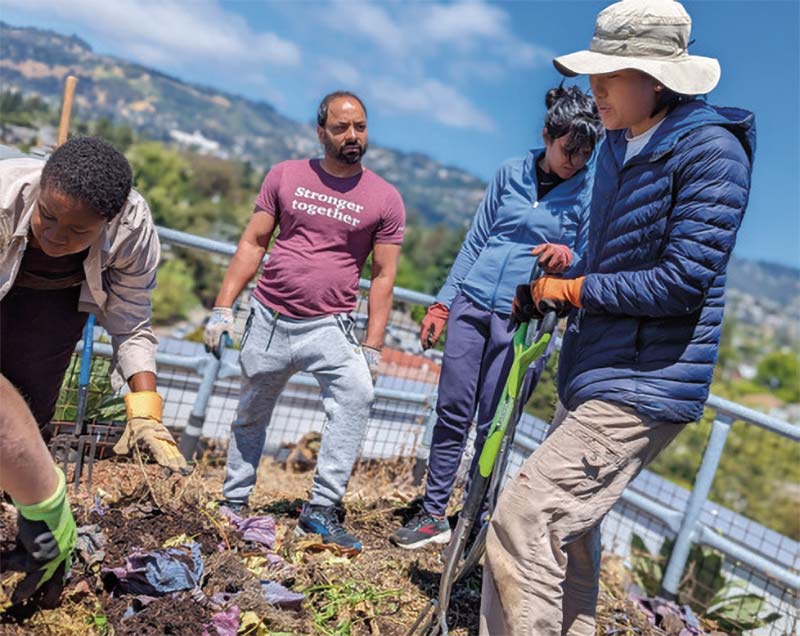
EXPANDING THE CIRCLE
“What’s that you say? / You don’t know the way?/ Did they sell your water and your DNA?…/ Interrupt the feed, unplug the greed, stop the bleed / Start with the seed, be what you need, get yourself free…” —Title track for “Growing Upward,” Rupa & the April Fishes
Beneath azure skies and puffs of cloud cover, a diverse band of gardeners gently plucks tall stalks from the soil, shakes away the dirt, unsheathes the garlic and plops it in a growing pile.
It’s the weekly volunteer day on the roof in Oakland, and the multiethnic mix of students, doctoral residents, social justice activists and a journalist are making work of weeding, composting and harvesting things like strawberries the size of a kid’s fist.
Rooftop harvest manager Meredith Song and field manager Victoria Chavez—who also support DMC’s robust intern education program—lead the group from task to task.
“We have a chance to value and pay farmers as people closely involved with the health of the community,” Song says at one point.
“Growing nutrient-dense food and giving it to people within a day means they get peak nutrients,” Chavez says, brushing dark dirt from a garlic bulb. “The fresher you eat it, the more vitamins and minerals you get! And when we provide it for free, we liberate food from the capitalist system.”
An irony accompanies this language, and the wider Deep Medicine effort: Paying farmers like doctors and making food free can sound radical. But ultimately prevention is practical, or about as un-radical as it gets. Fahrer helps put it in perspective: “What’s radical is the imagination needed to solve what’s ailing us.”
The additional layer of irony there: The solutions aren’t complicated. Happy soil grows happy plants. Fresh produce fights inflammation. Permaculture is based on 10,000-year-old practices.
Rupa Marya, the visionary doctor whose bona fides include marrying a farmer, has another key qualification that leads to those solutions: paying attention.
“Listening to the land, listening to what the fires are telling, listening to the family on the street, listening to Native people whose voices have been silenced, listening to my patients,” Marya says, “I feel like the work of my whole life is learning how to listen.”
Now she’s trusting others will too.
About the author
Mark C. Anderson, Edible Monterey Bay's managing editor, appears on "Friday Found Treasures" via KRML 94.7 every week, a little after 12pm noon. Reach him via mark@ediblemontereybay.com.
- Mark C. Andersonhttps://www.ediblemontereybay.com/author/markcanderson/
- Mark C. Andersonhttps://www.ediblemontereybay.com/author/markcanderson/
- Mark C. Andersonhttps://www.ediblemontereybay.com/author/markcanderson/
- Mark C. Andersonhttps://www.ediblemontereybay.com/author/markcanderson/


